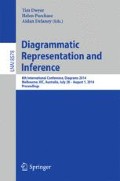Abstract
The aim of this paper is to study the relationship between two important families of diagrams that are used in logic, viz. Aristotelian diagrams (such as the well-known ‘square of oppositions’) and Hasse diagrams. We discuss some obvious similarities and dissimilarities between both types of diagrams, and argue that they are in line with general cognitive principles of diagram design. Next, we show that a much deeper connection can be established for Aristotelian/Hasse diagrams that are closed under the Boolean operators. We consider the Boolean algebra \(\mathbb{B}_n\) with 2n elements, whose Hasse diagram can be drawn as an n-dimensional hypercube. Both the Aristotelian and the Hasse diagram for \(\mathbb{B}_n\) can be seen as (n − 1)-dimensional vertex-first projections of this hypercube; whether the diagram is Aristotelian or Hasse depends on the projection axis. We show how this account provides a unified explanation of the (dis)similarities between both types of diagrams, and illustrate it with some well-known Aristotelian/Hasse diagrams for \(\mathbb{B}_3\) and \(\mathbb{B}_4\).
Access this chapter
Tax calculation will be finalised at checkout
Purchases are for personal use only
Preview
Unable to display preview. Download preview PDF.
References
Howse, J., Stapleton, G., Taylor, J.: Spider diagrams. LMS Journal of Computation and Mathematics 8, 145–194 (2005)
Rodgers, P.: A survey of Euler diagrams. J. of Visual Lang. & Comp. (in press)
Shin, S.J.: The Iconic Logic of Peirce’s Graphs. MIT Press (2002)
Stapleton, G.: A survey of reasoning systems based on Euler diagrams. Electronic Notes in Theoretical Computer Science 134, 127–151 (2005)
Stapleton, G., Howse, J., Rodgers, P.: A graph theoretic approach to general Euler diagram drawing. Theoretical Computer Science 411, 91–112 (2010)
Davey, B., Priestley, H.: Introduction to Lattices and Order. Cambridge U. P. (2002)
Demey, L.: Algebraic aspects of duality diagrams. In: Cox, P., Plimmer, B., Rodgers, P. (eds.) Diagrams 2012. LNCS, vol. 7352, pp. 300–302. Springer, Heidelberg (2012)
Demey, L.: Structures of oppositions for public announcement logic. In: Béziau, J.Y., Jacquette, D. (eds.) Around and Beyond the Square of Opposition, pp. 313–339. Springer (2012)
Moretti, A.: The Geometry of Logical Opposition. Ph.D. thesis, Neuchâtel (2009)
Smessaert, H.: Boolean differences between two hexagonal extensions of the logical square of oppositions. In: Cox, P., Plimmer, B., Rodgers, P. (eds.) Diagrams 2012. LNCS (LNAI), vol. 7352, pp. 193–199. Springer, Heidelberg (2012)
Smessaert, H.: The classical Aristotelian hexagon versus the modern duality hexagon. Logica Universalis 6, 171–199 (2012)
Smessaert, H., Demey, L.: Logical geometries and information in the square of oppositions. Forthcoming in Journal of Logic, Language and Information (2014)
Zellweger, S.: Untapped potential in Peirce’s iconic notation for the sixteen binary connectives. In: Houser, N., Roberts, D.D., Van Evra, J. (eds.) Studies in the Logic of Charles Peirce, pp. 334–386. Indiana University Press (1997)
Hurley, P.J.: A Concise Introduction to Logic, 11th edn. Wadsworth (2012)
Bernhard, P.: Visualizations of the square of opposition. Log. Univ. 2, 31–41 (2008)
Seuren, P.: The Logic of Language. Oxford University Press (2010)
Carnielli, W., Pizzi, C.: Modalities and Multimodalities. Springer (2008)
Lenzen, W.: How to square knowledge and belief. In: Béziau, J.Y., Jacquette, D. (eds.) Around and Beyond the Square of Opposition, pp. 305–311. Springer (2012)
McNamara, P.: Deontic logic. In: Stanford Encyclopedia of Philosophy (2010)
Moretti, A.: The geometry of standard deontic logic. Log. Univ. 3, 19–57 (2009)
Blanché, R.: Structures Intellectuelles. Vrin (1966)
Jacoby, P.: A triangle of opposites for types of propositions in Aristotelian logic. New Scholasticism 24, 32–56 (1950)
Sesmat, A.: Logique II. Les Raisonnements. La syllogistique. Hermann (1951)
Béziau, J.Y.: New light on the square of oppositions and its nameless corner. Logical Investigations 10, 218–232 (2003)
Ganter, B., Stumme, G., Wille, R. (eds.): Formal Concept Analysis. LNCS (LNAI), vol. 3626. Springer, Heidelberg (2005)
Chatti, S., Schang, F.: The cube, the square and the problem of existential import. History and Philosophy of Logic 32, 101–132 (2013)
Smessaert, H.: On the 3D visualisation of logical relations. Logica Universalis 3, 303–332 (2009)
Smessaert, H., Demey, L.: Logical and geometrical complementarities between Aristotelian diagrams. In: Dwyer, T., Purchase, H.C., Delaney, A. (eds.) Diagrams 2014. LNCS (LNAI), vol. 8578, pp. 248–262. Springer, Heidelberg (2014)
Foldes, S.: A characterization of hypercubes. Discr. Math. 17, 155–159 (1977)
Harary, F., Hayes, J.P., Wu, H.J.: A survey of the theory of hypercube graphs. Computers & Mathematics with Applications 15, 277–289 (1988)
Kauffman, L.H.: The mathematics of Charles Sanders Peirce. Cybernetics & Human Knowing 8, 79–110 (2001)
Flower, J., Stapleton, G., Rodgers, P.: On the drawability of 3D Venn and Euler diagrams. Journal of Visual Languages & Computing (in press)
Sauriol, P.: Remarques sur la théorie de l’hexagone logique de Blanché. Dialogue 7, 374–390 (1968)
Tversky, B.: Prolegomenon to scientific visualizations. In: Gilbert, J.K. (ed.) Visualization in Science Education, pp. 29–42. Springer (2005)
Tversky, B.: Visualizing thought. Topics in Cognitive Science 3, 499–535 (2011)
Strang, G.: Introduction to Linear Algebra. Wellesley-Cambridge Press (2009)
Givant, S., Halmos, P.: Introduction to Boolean Algebras. Springer (2009)
Smessaert, H., Demey, L.: The unreasonable effectiveness of bitstrings in logical geometry. In: 4th World Congress on the Square of Opposition (2014)
Author information
Authors and Affiliations
Editor information
Editors and Affiliations
Rights and permissions
Copyright information
© 2014 Springer-Verlag Berlin Heidelberg
About this paper
Cite this paper
Demey, L., Smessaert, H. (2014). The Relationship between Aristotelian and Hasse Diagrams. In: Dwyer, T., Purchase, H., Delaney, A. (eds) Diagrammatic Representation and Inference. Diagrams 2014. Lecture Notes in Computer Science(), vol 8578. Springer, Berlin, Heidelberg. https://doi.org/10.1007/978-3-662-44043-8_23
Download citation
DOI: https://doi.org/10.1007/978-3-662-44043-8_23
Publisher Name: Springer, Berlin, Heidelberg
Print ISBN: 978-3-662-44042-1
Online ISBN: 978-3-662-44043-8
eBook Packages: Computer ScienceComputer Science (R0)

